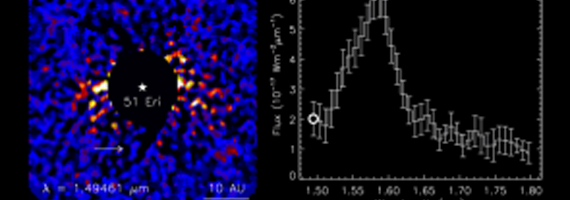
Gemini Planet Imager Discovers its First New Exoplanet
Katie Morzinski, an assistant astronomer at Steward Observatory, is an instrument builder who uses "extreme" adaptive optics (AO) to study extrasolar planets. She helped develop the Gemini Planet Imager (GPI) for Gemini Observatory in Chile, and is now the instrument scientist for the Magellan AO system, also in Chile. Katie is part of an international team, the GPI Exoplanet Survey, that has just announced the discovery of GPI's first new planet. The planet, 51 Eri b, is the closest yet we've gotten to imaging a young Jupiter. It is fainter and cooler than the other exoplanets that have been imaged with AO, requiring the specialized GPI instrument to unearth it from the bright glare of its host star. The GPI spectrum shows that the planet's atmosphere has methane (CH4) gas, which is also found in the Solar System giant planets and is a sign of a cool atmosphere. THIS FIGURE, an animated gif, by GPI team members Robert De Rosa and Christian Marois illustrates how GPI images the planet and measures its spectrum simultaneously. The planet is brightest at 1.6 micron, and is fainter to either side where water and methane are responsible for absorbing some of its flux. Katie looks forward to using Magellan AO's complementary capabilities to study the atmosphere of 51 Eri b at different wavelengths on the next MagAO observing run. More information on 51 Eri b may be found HERE and the Science paper is HERE.

For Public
Public events include our Monday Night Lecture Series, world-reknowned Astronomy Camp and Mt Lemmon Sky Center.

For Students
A good place to start if you want to become an undergrad major or grad student, or need to find our schedule of classes.

For Scientists
Find telescopes and instruments, telescope time applications, staff and mountain contacts, and faculty and staff scientific interests.




